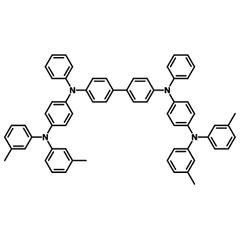DNTPD
CAS Number 199121-98-7
Electron / Hole Transport Layer Materials, High Purity Sublimed Materials, Semiconducting Molecules
DNTPD, HTL and HIL material in OLED and perovskite solar cell devices
Used to improve the current efficiency at ITO interface
Bearing four triarylamine units, DNTPD is electron rich and normally used as hole transport or hole injection layer material in OLED and perovskite solar cell devices. It is an extended structure of TPD and NPB that are widely used in organic electronics.
DNTPD layer at ITO interface can reduce the hole injection barrier while at the same time improve the current efficiency by balancing the holes and electrons in the emitting layer of an OLED device.
General Information
| CAS number | 199121-98-7 |
|---|---|
| Full name | N1,N1'-(Biphenyl-4,4'-diyl)bis(N1-phenyl)-N4,N4-di-m-tolylbenzene-1,4-benzenediamine |
| Chemical formula | C64H54N4 |
| Molecular weight | 879.1 g/mol |
| Absorption* | λmax 326 nm in DCM |
| Fluorescence | λem 473 nm in DCM |
| HOMO/LUMO | HOMO = 5.1 eV, LUMO = 2.1 eV [1] |
| Synonyms | N,N'-Bis{4-[bis(3-methylphenyl)amino]phenyl}-N,N'-diphenyl-4,4'-biphenyldiamine |
| Classification / Family | Triarylamines, Organic electronics, Hole-injection layer materials (HIL), Hole transport layer (HTL) materials, Sublimed materials. |
* Measurable with an optical spectrometer, see our spectrometer application notes.
Product Details
| Purity | Sublimed* >99% (HPLC) |
|---|---|
| Melting point | TGA: >250 °C (0.5% weight loss) |
| Appearance | Yellow powder/crystals |
* Sublimation is a technique used to obtain ultra pure-grade chemicals, see sublimed materials.
Chemical Structure

Device Structure(s)
| Device structure | ITO/DNTPD (40nm)/Bebq2:Ir(mphmq)2(tmd) (3%, 30 nm)/Bebq2 (20 nm)/LiF (0.5 nm)/Al (100 nm) [2] |
|---|---|
| Colour | Red |
| Max. Power Efficiency | 32.0 lm W-1 |
| Max. Current Efficiency | 30.1 cd/A |
| Max. EQE | 24.6% |
| Device structure | ITO/DNTPD (40nm)/Bebq2:Ir(mphmq)2acac (3%, 30 nm)/Bebq2 (20 nm)/LiF (0.5 nm)/Al (100 nm) [2] |
|---|---|
| Colour | Red |
| Max. Power Efficiency | 32.7 lm W-1 |
| Max. Current Efficiency | 29.1 cd/A |
| Max. EQE | 22.2% |
| Device structure | ITO (150 nm)/DNTPD (60 nm)/NPB (20 nm)/mCP (10 nm)/mCPPO1:FCNIrpic (30 nm, 3 %)/TSPO1(20 nm)/LiF (1 nm)/Al (200 nm) [3] |
|---|---|
| Colour | Blue |
| Power Efficiency@100 cd/cm2 | 19.7 lm W-1 |
| EQE@100 cd/cm2 | 22.3% |
| Device structure | ITO (150nm)/DNTPD (60 nm)/NPB (5 nm)/FPCA (10 nm)/mCPPO1*:FCNIrpic (30 nm, 3%)/TSPO1* (25 nm)/LiF(1 nm)/Al(200 nm) [4] |
|---|---|
| Colour | Blue |
| Max. Power Efficiency | 25.2 lm W-1 |
| Max. Current Efficiency | 26.0 cd/A |
| Max. EQE | 22.0% |
| Device structure | ITO (150 nm)/DNTPD (60 nm)/NPB (20 nm)/FPCA (10 nm)/BSFM*:Ir(ppy)3/TSPO1 (25 nm)/LiF (1 nm)/Al (200 nm) [4] |
|---|---|
| Colour | Green |
| Max. Power Efficiency | 58.5 lm W-1 |
| Max. Current Efficiency | 79.0 cd/A |
| Max. EQE | 24.5% |
*For chemical structure information, please refer to the cited references.
Pricing
| Grade | Order Code | Quantity | Price |
|---|---|---|---|
| Sublimed (>99% purity) | M2193A1 | 250 mg | £340 |
| Sublimed (>99% purity) | M2193A1 | 500 mg | £560 |
| Sublimed (>99% purity) | M2193A1 | 1 g | £900 |
MSDS Documentation
Literature and Reviews
- Blue Phosphorescent Organic Light-Emitting Devices with the Emissive Layer of mCP:FCNIr(pic), J. Jang et al., Adv. Mater. Sci. & Eng., 192731 (2012); doi:10.1155/2012/192731.
- Highly Efficient Red Phosphorescent Dopants in Organic Light-Emitting Devices, D. Kim et al., Adv. Mater., 23, 2721–2726 (2011); DOI: 10.1002/adma.201100405.
- External Quantum Effi ciency Above 20% in Deep Blue Phosphorescent Organic Light-Emitting Diodes, S. Jeon et al., Adv. Mater., 23, 1436–1441 (2011); DOI: 10.1002/adma.201004372.

 DNTPD MSDS sheet
DNTPD MSDS sheet